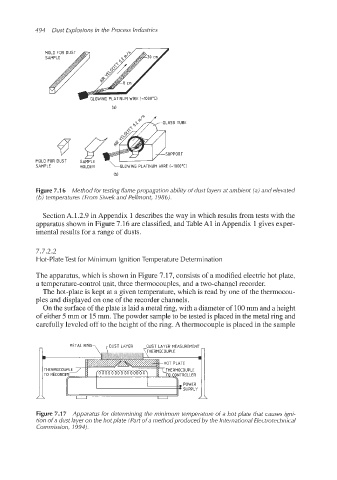Page 527 - Dust Explosions in the Process Industries
P. 527
494 Dust Explosions in the Process industries
MOLD FOR DUST s
SAMPLE H WIRE (-IOOO'CI
Figure 7.1 6 Method for testing flame propagation ability of dust layers at ambient (a) and elevated
(b) temperatures (From Siwek and Pellmont, 1986).
Section A. 1.2.9 in Appendix 1 describes the way in which results from tests with the
apparatus shown in Figure 7.16 are classified, and Table A1 in Appendix 1 gives exper-
imental results for a range of dusts.
7.7.2.2
Hot-Plate Test for Minimum Ignition Temperature Determination
The apparatus, which is shown in Figure 7.17, consists of a modified electric hot plate,
a temperature-control unit, three thermocouples, and a two-channel recorder.
The hot-plate is kept at a given temperature, which is read by one of the thermocou-
ples and displayed on one of the recorder channels.
On the surface of the plate is laid a metal ring, with a diameter of 100 rnm and a height
of either 5 mm or 15 111111. The powder sample to be tested is placed in the metal ring and
carefully leveled off to the height of the ring. A thermocouple is placed in the sample
Figure 7.1 7 Apparatus for determining the minimum temperature of a hot plate that causes igni-
tion of a dust layer on the hot plate (Part of a method produced by the international Electrotechnical
Commission, 1994).

